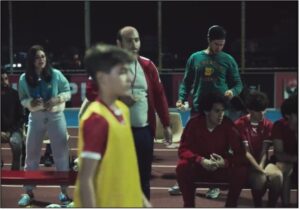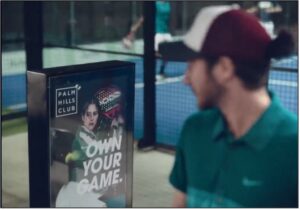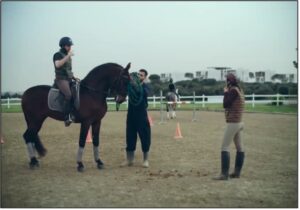Abstract
This article examines brand storytelling and utilizes a qualitative analysis of two advertising campaigns. This article endeavors to research this content as a means of inspiring positive change, challenging stereotypes, and promoting gender equality. The research focuses on two distinct advertising campaigns, which are Allianz Classics (2015) for Allianz Deutschland in Germany and Badya Stories (2022) for Badya Palm Hills in Egypt. These two advertising campaigns exemplify on how brand storytelling in advertising can challenge stereotypes and traditional gender roles. The Allianz Classics campaign effectively challenged conventional gender roles in professions associated with healthcare, law enforcement, and managerial positions, as well as in traditional household responsibilities. The storytelling in the Badya Stories campaign challenged gender roles in professional work environments and athletics. However, the campaign neglected other aspects of daily life and social situations, which may unintentionally perpetuate traditional stereotypes. Findings highlight the potential for brands to utilize storytelling as a tool to challenge conventional gender roles and promote gender equality.
Introduction
In today’s competitive advertising landscape, brands constantly seek innovative methods to connect with their audience and generate a lasting impact. One approach is brand storytelling, which transcends traditional advertising techniques by creatively embedding narratives in advertising to convey messages and transfer meanings, which consequently attracts attention, generates connections, and evokes emotions.
Unlike traditional advertising that focuses on a particular brand or product, brand storytelling relies upon a creative narrative as the focus of the advertising message. As such, the brand takes a more peripheral role in brand storytelling. Campaigns that employ brand storytelling aim to produce memorable advertisements by immersing viewers in a narrative, which may allow viewers to identify with the characters. Through narratives and character attributes, brands communicate messages that may inspire positive change, challenge traditional stereotypes, and present alternative socio-cultural practices. This article explores the power of brand storytelling by examining two advertising campaigns, which specifically challenge traditional gender roles.
This research is scientifically important because it explores how brand storytelling can challenge and redefine traditional gender roles. The examination of these two specific campaigns provides insight into the potential impact of brand storytelling, particularly as it relates to the promotion of gender equality and elimination of societal stereotypes. This research contributes to the existing corpus of literature on gender studies and advertising research, particularly as it relates to Egypt and Germany. The research offers an examination regarding the portrayal of gender roles in advertising and highlights the need for more comprehensive and inclusive representations.
From an applied perspective, this study offers practical significance for brands and advertisers. The findings emphasize the power of storytelling in shaping societal perceptions and suggest that brands can play a significant role in challenging traditional gender roles. By recognizing missed opportunities and ensuring a more comprehensive approach, advertisers can create impactful campaigns that promote gender equality and resonance with a broad audience. Ultimately, this study provides valuable insights regarding the potential of brand storytelling and its potential to promote a more inclusive society. The findings offer guidance to brands and advertisers seeking to create impactful campaigns that contribute to positive social change.
Literature Review
The literature review section examines the two components involved in this study, which are brand storytelling and gender roles in Egyptian advertising. Through the examination of previous research, the literature review provides the foundation for this study by contextualizing the analysis of the brand storytelling techniques in Allianz Classics and Badya Stories campaigns. The initial portion delves into the theoretical underpinnings of storytelling as a persuasive tool and examines its capacity to shape perceptions, challenge norms, and evoke emotional responses. The examination of the theoretical underpinnings of brand storytelling and previous research on gender in Egyptian advertising, provides a theoretical foundation to examine the selected brand storytelling campaigns.
The evolving nature of these portrayals provides a backdrop for understanding the potential impact and significance of campaigns like Badya Stories in challenging traditional gender roles and promoting inclusive narratives in the Egyptian society. This is particularly pertinent because gender roles are evolving in Egypt and episodic brand storytelling was recently introduced.
Brand Storytelling
Brand storytelling is a powerful tool for marketers to influence consumer perceptions, attitudes, and buying behavior. According to Crespo, Ferreira, and Cardoso (2023) brand storytelling has the potential to influence buying intentions through a combination of emotional reactions and cognitive processes. More specifically, brand storytelling can increase consumer-brand identification and boost brand affective involvement.
Similar to the aforementioned findings, a systematic literature review conducted by Júnior et. al (2023) identified four main components in the marketing literature regarding the uses of brand storytelling to influence consumers’ purchasing behavior.
First, consumers are more likely to identify with a brand when its storytelling is effectively communicated. This is achieved by communicating narratives and values that create a sense of connection and resonance with consumers, which may lead to increased brand loyalty and purchase intentions. Second, compelling narratives can evoke an emotional response in consumers, which can influence their attitudes and behaviors regarding the brand. A consumer’s emotional engagement with a brand’s story can enhance the overall brand experience and drive purchasing decisions. Third, brand storytelling can encourage consumers to actively engage with the brand, through social media interactions, sharing their own stories, or participating in brand-related activities, which can positively impact purchasing behavior and brand advocacy. Fourth, brands need to be cautious in their storytelling efforts to avoid negative repercussions and ensure that narratives align with ethical and responsible practices.
The importance of a comprehensive understanding of brand storytelling in marketing and advertising was highlighted by Pereira (2019), who argued that simply incorporating storytelling into these practices is not enough. Instead, campaigns that utilize brand storytelling must consider a three-dimensional perspective, which includes customer journey, brand identity, and market or context. These three dimensions are integral to the creation of an effective brand storytelling campaign. As such, if a narrative does not align with the plot, the character, or the world, it will likely fail to resonate with customers and may not effectively communicate the brand message. Additionally, a brand storytelling campaign can rely upon a fictional or a factual plot. Xie (2021) examined how a specific brand story influences a consumer’s attitude toward a brand. The findings suggest that brand stories—either fictional or factual—can have varying impact on consumer perceptions or brand attitudes, which highlights the importance of carefully crafting brand stories to effectively shape consumer attitudes toward brands.
Different narrative constructs could be employed while producing brand storytelling advertisements. The brand story anthology, presented by Smith and Wintrob (2013, 36), identified four brand storytelling constructs, which are heritage, contemporary, folklore, and vision stories. Heritage stories focus on the brand's origins and explain why it possesses certain qualities. These stories provide a historical context and help consumers understand the roots and traditions of a brand and cultivate a bond with the brand. Contemporary stories are narratives that utilize multiple intersecting plotlines, which reflect the brand’s current values, goals, and activities. These types of stories help shape the brand’s present image, which might include aspects such as brand promise, technologies, and innovations. Folklore stories are the narratives that others say about a brand. These stories are not directly controlled by the brand but are shared organically by consumers, fans, and other stakeholders, which can include popular beliefs, myths, and parodies. Folklore stories contribute to the brand’s culture and sub-cultures, adding depth and meaning to its identity. Vision stories focus on imagining a future state for the brand. These stories create a narrative around the brand’s long-term goals and aspirations and help shape the brand’s legacy and impact by creating a strategy through ideas and tactics. By utilizing these different brand storytelling constructs, brands can create a comprehensive and engaging brand narrative that connects with consumers on multiple levels.
It is worth noting that brand storytelling is no longer the exclusive domain of brands, as consumers increasingly have the capacity to share their experiences, which influence brand storytelling. However, while brand storytelling that originates from a brand or firm has been well-established as an effective marketing tool, consumer generated brand storytelling that is created and shared among consumers has generated less empirical research (Hong et al. 2022). Despite the lack of research, the impact of consumer produced brand storytelling on brand evaluations, compared to brand stories created by firms, was investigated by Hong et al. (2022). The research relied upon three experiments while using different product categories and brands. The findings indicate that consumer produced brand storytelling enhances favorable brand attitudes, elicits deeper cognitive processing, and higher levels of positive emotions, which ultimately lead to more favorable brand evaluations, as compared to firm-created brand stories.
Additional mechanisms that effect storytelling may include variables related to the characters within the storytelling, such as their age, gender, brand-congruity, or conformity to the audience. These variables can influence how the audience perceives and relates to the characters, which can impact the effectiveness of the brand storytelling campaign, as well as the attitudes towards the advertisements and brands. For example, Chen, Wang, and Zhou (2023) investigated inspirational brand stories and the influence of a lead character’s gender on consumer-brand identification. They conducted two experiments involving brand storytelling and found the gender of the lead character elicited an impact on consumer brand identity, which was mediated by sympathy. That is, viewers were more sympathetic to female characters as compared to male ones, which increased brand identification. This gender effect is strengthened by perceived conformance to gender roles.
Considering the aforementioned findings, it is logical that brands might integrate this knowledge into brand storytelling strategies to more effectively appeal to their target audience. For example, Zhang et al. (2023) examined how storytelling should be modified if it aims to appeal to the younger generation, as exemplified by Generation Z. The research conducted a focus group involving a case study on Disney’s new storytelling strategies. The findings suggest that storytelling has undergone changes in terms of content, advertising channels, and the role of the company to cater to Generation Z within the context of digital marketing. Brands also might extend their storytelling techniques into other forms of media. In reference to digital marketing, Scozzese and Cavallini (2023) reviewed the concept of transmedia storytelling, which involves creating a fictional universe that extends across multiple media platforms. It offers an immersive and engaging experience for the audience, which has the potential to promote products or services through multiple media channels.
The use of brand storytelling in advertising may also reflect gender perspectives and stereotypes. For instance, Sezer and Gül Ünlü (2017) examined the use of storytelling in digital advertising by Turkish Airlines, particularly as it relates to gender perspectives and stereotypes. They found these advertisements presented a gendered perspective, which reinforced traditional gender stereotypes. This suggests that storytelling in advertising can perpetuate gender biases and expectations. It also highlights the importance of critically examining the use of storytelling in advertising to challenge and reshape gender representations.
Gender Roles in Egyptian Advertising
The portrayal of gender roles in Egyptian primetime television commercials was analyzed by Ahmad (2002), which compared the commercial portrayals to gender roles that were prevalent in Egyptian society. The findings identified numerous instances of stereotypical portrayals of gender in Egyptian television commercials. Similarly, Ishak (2003) found evidence of stereotyping women in Egyptian television commercials while analyzing a sample of Egyptian primetime television commercials. For example, women were associated with domestic products and were often depicted at home. Meanwhile, men were associated with non-domestic products and often portrayed in outdoor settings. Along the same lines, Nordén (2006) examined representations of gender in Egyptian magazine advertisements in comparison to Swedish magazine advertisements. The research endeavored to understand how such advertisements reinforce or challenge gender roles. The findings reveal that both men and women in Egyptian ads were portrayed according to Western consumer culture. More specifically, men were portrayed as determined or sexy and associated with work or relaxation, while women were often depicted as innocent or beautiful. These portrayals reflected societal ideals influenced by Western norms. Similarly, Arafa (2013) highlighted the presence of stereotypes and negative imagery toward women in the Egyptian television and magazine advertising, which perpetuates inequality, sexuality, and objectification. These findings align with El-Sherbini et al. (2017), who analyzed the representation of women in Egyptian television commercials. The study accounted for several variables, including age, occupation, physical appearance, lifestyle, context (rural or urban), social roles, values, and stratifications. The research concluded that Egyptian women were not adequately depicted in television advertising.
On the contrary, Abboud (2020) investigated the shift towards more positive gender representation in advertising, which highlighted changing gender representations. For example, women were frequently portrayed in sport venues and work environments, rather than in traditional domestic contexts. These changes were attributed to the sociocultural changes and the influence of digital advertising on the perceptions and attitudes of young Egyptians. Another attribution would consider the gradual evolution of female representation as a response to the feminist movement. El-Sheikh, Farag, and El-Arousy (2014) explored the historical background of female gender representation in advertising, which identified the existence of stereotypical portrayals that confine women to specific gender roles. However, the authors also acknowledged the influence of the four waves of feminism, which subsequently elicited changes in female portrayals in advertising. This developed into a trend of feminist advertising referred to as femvertising, which portrays women as empowered, rather than depicting them as subservient or objectified.
The conceptual framework for this research is based on the two pillars: brand storytelling and gender roles in Egyptian advertising. The first pillar, brand storytelling, recognizes the potential of narratives and storytelling techniques to influence attitudes and drive behavior change. The article studies an advertising campaign that utilizes brand storytelling, which was selected to offer insights into brand storytelling techniques and how they are employed to represent gender in a way that may challenge traditional roles. The second pillar, gender roles in Egyptian advertising, draws upon previous research and scholarly work that examines the portrayal of women in advertising in Egypt. This body of literature provides insight into the social context and prevailing gender stereotypes in Egyptian advertising. It highlights previous studies that identified negative and traditional portrayal of women in advertising and acknowledges how these roles have gradually shifted toward more progressive and empowering representations. The second case study seeks to understand how advertising campaigns in Egypt utilized brand storytelling techniques to represent gender roles. By integrating these two frameworks, the study aims to shed light on the central phenomenon under investigation, which is gender representation in different contexts through brand storytelling. Therefore, the article has one research question as follows:
- RQ: “How do the Allianz Classics and Badya Stories episodic campaigns use brand storytelling to represent gender roles in different contexts?”
Methodology
This article uses a qualitative content analysis method and a convenient sample of episodic brand storytelling campaigns are analyzed with the aim to exemplify how brands can use brand storytelling to represent, reinforce, or challenge traditional gender roles in different contexts. To provide a multi-dimensional perspective and a holistic view of the phenomenon being studied, the case study approach is adopted (Kohlbacher 2006). Case study research is a method that allows researchers to investigate specific or multiple cases to draw conclusions about phenomena in the context of marketing (Gummesson 2005).
The two campaigns chosen for the analysis are Allianz Classics campaign from Germany and the Badya Stories campaign from Egypt. The selection of two specific campaigns is based on their relevance to the central phenomenon under investigation, which is gender roles in brand storytelling. Due to the unique nature of case study research, determining a specific number of cases required to draw meaningful conclusions is not logical. The selection of cases is based on a theoretical and purposeful approach, which aim to gather maximum information. Ideally, the process is guided by saturation, which signifies the point at which little or no new information emerges (Gummesson 2005). Analyzing the selected campaigns allow for a comprehensive exploration of how brands, internationally and nationally, are leveraging storytelling to challenge stereotypes and traditional gender roles.
On one hand, the Allianz Classics (2015) campaign by Allianz Deutschland in Germany serves as an appropriate international example of a brand storytelling campaign that focuses on gender norms. The selection of Allianz Classics (2015) as a case study is based on the research of Zimmermann (2021, 226) who analyzed the campaign and identified some noteworthy findings. In particular, the research examines how the campaign challenged conventional gender roles. Drawing upon the analysis of Zimmermann (2021), this article seeks to further explore Allianz Classics to analyze how this campaign utilized brand storytelling to represent gender roles in different contexts.
On the other hand, the Badya Stories (2022) campaign by Badya Palm Hills in Egypt represents a national advertising campaign that also aligns with the study’s focus on gender roles in brand storytelling. This campaign was chosen as a convenient sample due to its inclusion of two main characters, one from each gender. The selection of this campaign was also driven by the recency and scarcity of this type of episodic brand storytelling in Egyptian advertising.
The unit of analysis was each episode within the entire brand storytelling campaign, as each advertising campaign consists of multiple episodes or a set of connected television commercials, which incorporate the same theme. These episodes are available on the YouTube channels of Allianz Deutschland and Palm Hills Development. These episodes were analyzed scene by scene, as well as in relation to the entire campaign theme, to provide insights regarding gender roles in brand storytelling utilized by one national and one international brand.
Case Study 1: Allianz Classics
The German series of commercials titled Allianz Klassiker, which translated to Allianz Classics, that were produced by Allianz Deutschland are intended to highlight the company’s long-standing presence in the insurance industry. By juxtaposing old commercials with shot-to-shot remakes in contemporary settings, Allianz Deutschland showcases the industry’s evolution over the past few decades (Zimmerman 2021). The series of commercials utilize a split-screen technique to juxtapose the historical and contemporary advertisements (Zimmermann 2021).
In the contemporary remake of the commercial called Unfall, which translates to Accident, the woman is depicted as preparing to leave for work while the father stays at home with the child (Fig 1). According to Zimmerman (2021) this challenges gender roles that are typically associated with parenting responsibilities.
 Fig 1: Allianz Klassiker / Unfall (2015)
Fig 1: Allianz Klassiker / Unfall (2015)
This portrayal reflects a shift towards more egalitarian and progressive values involving family dynamics while moving away from the traditional roles. As reflected in the earlier commercial on the left side of the screen, women occupied traditional roles in society as they were expected to take on the primary caregiving role Meanwhile, men were traditionally portrayed as the household breadwinners. The contemporary representation implies the importance of shared responsibilities and equal involvement of both parents in raising children and managing household tasks. Further, it supports the individual freedom to pursue chosen career paths and roles within the family.
In the same commercial, a later sequence depicts a contemporary remake of a hospital scene, which features a male playing the role of the nurse (Fig 2). This representation challenges traditional gender roles and stereotypes typically associated with healthcare professions.
 Fig 2: Allianz Klassiker / Unfall (2015)
Fig 2: Allianz Klassiker / Unfall (2015)
Historically, nursing has been predominantly portrayed as a female-dominated profession, while the profession of a doctor was perceived as reserved for males. By depicting a male nurse in the contemporary remake, the scene challenges the assumption that nursing is a profession reserved for women and highlights the fact that anyone, regardless of gender, can excel in any healthcare profession. This representation helps to promote inclusivity and diversity within the healthcare field by encouraging individuals to pursue their career aspirations regardless of societal gender-based expectations. Later in the same commercial there is a scene that depicts domestic life at home. In this sequence, the man occupies the role of domestic caretaker by making the women’s cup of tea (Fig 3), which challenges traditional gender roles and stereotypes associated with nurturing and caregiving.
 Fig 3: Allianz Klassiker / Unfall (2015)
Fig 3: Allianz Klassiker / Unfall (2015)
This portrayal challenges traditional gender roles and emphasizes the importance of care and support within a partnership, regardless of gender. Traditionally, women were expected to take on the nurturing and caregiving roles within the household. This scene demonstrates a shift toward a more supportive and balanced household dynamic, where the man occupies the role of providing care and comfort to the woman. It highlights the importance of empathy, emotional support, and mutual understanding within relationships regardless of societal gender-based expectations. These acts of care and support should not be limited to just one gender.
The same commercial subsequently depicts a contemporary remake of an office environment, where the woman is portrayed as the manager and the man is the secretary (Fig 4), which challenges gender roles traditionally associated with the workplace.
 Fig 4: Allianz Klassiker / Unfall (2015)
Fig 4: Allianz Klassiker / Unfall (2015)
This portrayal is a reversal of traditional gender roles, as depicted in the earlier commercial, and inverts the stereotype that positions of power and authority are reserved for men while administrative or support roles are traditionally for women.
The commercial aims to promote gender equality in the workplace. It highlights the concept that individuals should be judged based on their qualifications, rather than gender. In conclusion, the juxtaposed sequences in the Unfall commercial clearly challenge stereotypes and gender roles traditionally associated with parenting responsibilities, nurturing, caregiving, and healthcare professions, as well as managerial and secretarial positions in the workplace.
In the second commercial, which is titled Tomatenstapel and translates to Pile of Tomatoes, the police officer is portrayed by a woman (Fig 5). This depiction challenges the typical gender roles that are traditionally associated with law enforcement professions. This portrayal implies that women are equally capable of serving and protecting their communities and pursuing careers in traditionally male-dominated professions, which contrasts with traditional gender stereotypes that typically depict police officers as men.
 Fig 5: Allianz Klassiker / Tomatenstapel (2015)
Fig 5: Allianz Klassiker / Tomatenstapel (2015)
However, to challenge gender roles requires more than just swapping genders without considering the underlying messages, narrative contexts, and potential implications. Later in the sequence, the woman is depicted as riding a car to Napoli when she is distracted by a group of handsome men on the side of the street. Meanwhile in the classic scenario, the passenger in the car was a man who was distracted after gazing at a woman. Although this does invert the gender roles, nonetheless in both scenarios the person on the street—man or women—are not depicted as individuals. Instead, these depictions objectify these characters by reducing them to their appearances.
Case Study 2: Badya Stories
The commercial series titled Badya Stories (2022) is an advertising campaign for Badya Palm Hills, which is a real estate project located in Egypt. From a marketing perspective, the campaign aims to highlight the beauty and modernity of this real estate development in Cairo by showcasing its urban style and smart buildings. The campaign also showcases features and promote amenities of the new development. The campaign consists of thirteen one-minute episodes, which involve twelve different scenarios centered around a recurring female and male character—Nada and Hashem—that meet for the first time in the initial episode. The locations of each episode in the series of commercials are different, which include a range of places like sporting courts, entertainment venues, and workplace offices. The use of brand storytelling in an episodic series of commercials is unique in Egypt and potentially impactful as it engages the audience and creates a memorable experience. As Badya Palm Hills is likely one of the first companies in Egypt to utilize this technique of brand storytelling, it may make the campaign stand out and create a sense of novelty and intrigue. The analysis of the episodes examineshow the campaign depicts the roles, behaviors, and expectations of men and women. This is achieved by examining specific gender roles assigned to characters in the episodes, in terms of their occupations, activities, and interactions within the city, as well as highlighting instances of gender equality and challenging traditional norms.
In the episode titled The One at Football Practice, Nada and Hashem attend a football practice for juniors as they support and cheer for their respective relative family members (Fig 6). The commercial showcases a shared responsibility and involvement in supporting young children and challenges gender roles in traditionally male-dominated spaces, such as football courts. In addition, the campaign may break gender stereotypes by featuring a woman at a sporting venue, which could encourage more participation from women in Egypt in traditionally male-dominated sports.
 Fig 6: Badya Stories / The One at the Football Practice (2022)
Fig 6: Badya Stories / The One at the Football Practice (2022)
In The One at the Paddle Courts, a man and woman are depicted preparing to play a paddle ball game together at the Badya Palm Hills Club paddle courts. Hashem offers Nada a racket, assuming she may need it. However, after looking at an advertising sign, which is prevalently displayed courtside, he realizes the Nada is a professional paddle player at the club (Fig 7). This realization highlights the surprise, and perhaps admiration, for the Nada’s skill and expertise in the sport. This portrayal showcases the idea that a women can be highly skilled and accomplished in sports, which challenges traditional gender stereotypes and promotes the recognition of women’s achievements in athletic pursuits.
 Fig 7: Badya Stories / The One at the Paddle Courts (2022)
Fig 7: Badya Stories / The One at the Paddle Courts (2022)
Similarly, in the episode titled The One with The Horse, Nada breaks conventional gender roles as she is depicted as a riding instructor, which is often traditionally seen as a more masculine activity associated with the cavalry in old ancient times. Hashem jokingly asks her if she her name is Gomaa, a male’s name, which reflects the traditional gender stereotypes and expectations. As a result, this scenario presents an opportunity for the man to challenge his preconceived notions and remain amenable to receiving riding instructions from a female coach (Fig 8). This portrayal challenges gender norms and highlights the idea that anyone, regardless of their gender, can pursue an occupation in sports.
 Fig 8: Badya Stories / The One with the Horse (2022)
Fig 8: Badya Stories / The One with the Horse (2022)
In another episode titled The One at the Office, Hashem is walking through a workplace environment and enters a conference room to expresses his frustration to a coworker regarding a colleague named Nada, who he has not yet personally met. The ire of his discontent, Nada, is a female who is bombarding him with work-related emails. Hashem then frustratedly asks who Nada is, only for Nada to reply directly to his question as she is in the conference room. She responds to his complaints, and apology, in a formal manner (Fig 9). In the context of gender roles, this scenario could be viewed as challenging traditional stereotypes in the workplace. Nada is taking on a more assertive and proactive role as she takes the initiative by directly replying to Hashem’s complaints. Meanwhile, Nada is depicted as actively involved in her tasks while Hashem expresses his emotions, such as frustration, and is seeking clarifications from colleagues.
 Fig 9: Badya Stories / The One at the Office (2022)
Fig 9: Badya Stories / The One at the Office (2022)
These episodes of Badya Stories serve as examples of positive empowerment for women in Egypt while striving to challenge gender roles. However, there are instances within other episodes that inadvertently reinforce gender stereotypes, which depict women as dependent on men by seeking their guidance and assistance. For example, in the episode titled The One with the Key, Nada is at a coffee shop with a friend. Meanwhile, a male at the same counter is chatting with Hashem via video chat and puts the phone down for a moment to retrieve something from his bag. While engrossed in a conversation with her friend, Nada accidentally takes the man’s mobile phone as she picks up the coffee she ordered from the counter and puts the phone in her bag. She only realizes her mistake when she hears a man’s voice because the video chat is still open and Hashem is trying to get her attention. In another episode titled The One with the Notebook, Nada is corrected and mansplained to by Hashem regarding a spelling mistake in Arabic, which is a simple word that she had forgotten. Nada then leaves her notebook behind. In another episode titled The One in the Cinema, Nada arrives late to the cinema and mistakenly takes the wrong seat, which is the seat of an ancillary male character who subsequently corrects her. As she reseats herself in the correct seat, Nada asks the person next to her, Hashem, if she has missed anything in the film. In the episode titled The One with the Charger, Nada urgently requires a mobile charger and desperately seeks the help of a stranger, Hashem, who provides one to her.
Conclusion
Analyzing the Allianz Classics campaign from Germany and the Badya Stories campaign from Egypt allows for a comprehensive exploration of how one international and one national brand are leveraging brand storytelling to challenge stereotypes and traditional gender roles. This analysis affords insights into the local and global perspectives on this topic and uncovers valuable information and strategies that brands can employ to challenge traditional gender roles through brand storytelling. The storytelling in the Allianz Classics (2015) campaign effectively challenged gender roles associated with household responsibilities, such as nurturing, caregiving, and parenting. The campaign portrayed men and women interchangeably breaking free from traditional gender norms and occupying traditionally unconventional societal roles, which highlights that such responsibilities are not limited to one gender. The campaign challenged stereotypes associated with professions in healthcare, law enforcement, and managerial positions. It unconventionally showcased men and women in these fields by reconstructing gender roles and presenting a more diverse and inclusive representation of genders in workplace.
The storytelling in the Badya Stories (2022) campaign successfully challenged gender roles in sports and the workplace, which align with its goal of promoting a progressive and inclusive city. This finding is consistent with a positive shift in Egyptian advertising, as observed in the literature review (Abboud 2020; El-Sheikh, Farag, and El-Arousy 2014). The commercials reflect a growing recognition and emphasis on promoting inclusivity and empowering messages that challenge traditional gender roles.
At the same time, this finding can also be interpreted within the framework proposed by Zhang et al. (2023) from the literature review, which suggests that brands may employ changes in brand storytelling strategies as a marketing technique to effectively engage their target audience. The positive portrayal of women’s roles in the Badya Stories campaign appeals to a wider audience that values gender equality and equal opportunities, which indicates the campaign successfully employed this strategy to resonate with its intended viewers.
However, the Badya Stories campaign missed the opportunity to challenge gender roles in other aspects of daily life and social situations. For example, some of these episodes portrayed instances of women relying on men for guidance, assistance, or correction, which inadvertently perpetuates traditional gender stereotypes. Such examples might undermine the implied message of challenging gender roles and promoting gender equality. This finding is in accordance with the caution raised by Sezer and Gül Ünlü (2017) regarding brand storytelling advertisements potentially presenting a gendered perspective that reinforces traditional gender stereotypes. To create a more comprehensive and impactful campaign, it is important to address these missed opportunities and ensure that all aspects of women’s lives are represented in a way that challenges stereotypes and promotes gender equality. These findings provide the answer to the research question regarding how the two campaigns use brand storytelling techniques to represent gender roles. The practical implication of this article yields potential for brands to use brand storytelling as a tool to challenge traditional gender roles and promote gender equality.
Recommendations for future research include conducting audience surveys to gain insights into the impact and effectiveness of brand storytelling campaigns, such as Badya Stories, particularly as it pertains to challenging traditional gender roles in Egypt. Surveys can aid in determining if the brand storytelling campaigns successfully resonated with the target audience as well as influence attitudes and behaviors related to gender equality. In conclusion, brand storytelling plays a crucial role in challenging traditional gender roles, as evidenced by the Allianz Classics and Badya Stories campaigns. These campaigns utilized brand storytelling to challenge gender norms associated with household responsibilities and workplace professions. Moreover, these episodic commercials promoted a more inclusive society through a diverse representation of genders. This was achieved by showcasing men and women breaking free from traditional gender roles, which may encourage a shift in societal perceptions and challenge traditional gender expectations.
 Arab Media & Society The Arab Media Hub
Arab Media & Society The Arab Media Hub


 Fig 2: Allianz Klassiker / Unfall (2015)
Fig 2: Allianz Klassiker / Unfall (2015) Fig 3: Allianz Klassiker / Unfall (2015)
Fig 3: Allianz Klassiker / Unfall (2015) Fig 4: Allianz Klassiker / Unfall (2015)
Fig 4: Allianz Klassiker / Unfall (2015) Fig 5: Allianz Klassiker / Tomatenstapel (2015)
Fig 5: Allianz Klassiker / Tomatenstapel (2015) Fig 6: Badya Stories / The One at the Football Practice (2022)
Fig 6: Badya Stories / The One at the Football Practice (2022) Fig 7: Badya Stories / The One at the Paddle Courts (2022)
Fig 7: Badya Stories / The One at the Paddle Courts (2022) Fig 8: Badya Stories / The One with the Horse (2022)
Fig 8: Badya Stories / The One with the Horse (2022) Fig 9: Badya Stories / The One at the Office (2022)
Fig 9: Badya Stories / The One at the Office (2022)



